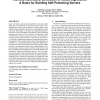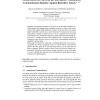162 search results - page 20 / 33 » Topological analysis of network attack vulnerability |
TDSC
2010
13 years 2 months ago
2010
Network survivability is the ability of a network keeping connected under failures and attacks, which is a fundamental issue to the design and performance evaluation of wireless ad...
INFOCOM
2006
IEEE
14 years 1 months ago
2006
IEEE
— As the commercial success of the IEEE 802.11 protocol has made wireless infrastructure widely deployed, user organizations are increasingly concerned about the new vulnerabilit...
CCS
2005
ACM
14 years 1 months ago
2005
ACM
Large-scale attacks, such as those launched by worms and zombie farms, pose a serious threat to our network-centric society. Existing approaches such as software patches are simpl...
CN
2008
13 years 8 months ago
2008
As more applications rely on underlying peer-to-peer topologies, the need for efficient and resilient infrastructure has become more pressing. A number of important classes of top...
WISA
2004
Springer
14 years 1 months ago
2004
Springer
Abstract. Encapsulating messages in onions is one of the major techniques providing anonymous communication in computer networks. To some extent, it provides security against traf�...


